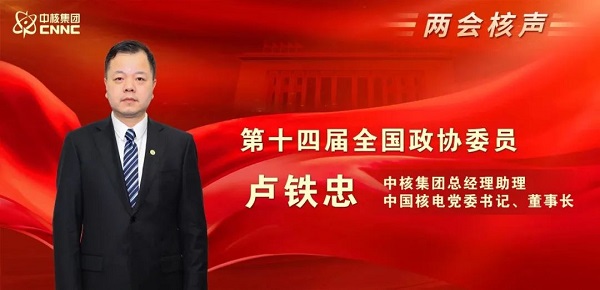Lu Tiezhong: Nuclear energy’s green attribute should be certified
Last year, the world's first carbon tariff mechanism CBAM began trial operation and will be officially implemented in 2026. Lu Tiezhong, chairman of China National Nuclear Power (CNNP), stated that for Chinese export enterprises, using green electricity is becoming increasingly urgent. However, in current trades of green electricity, green certificate, and carbon emission, the value of nuclear energy has not been clearly defined. It is necessary to further promote comprehensive integration of nuclear energy into China's green and low-carbon policy system, supporting high-quality development.

Nuclear energy's indispensable role in attaining the "dual carbon" goal
Lu Tiezhong said, nuclear energy is a clean, safe, and efficient energy source. It is a kind of key energy to ensure China's energy security and low-carbon transition, as well as an important force to promote China's high-quality development.
It is clear that nuclear energy possesses green and low-carbon attributes. Nuclear power is a clean energy source with high quality, high density, and zero emissions. The energy released from the fission of 1 kilogram of uranium-235 is equivalent to 2,700 tons of coal, and it does not emit carbon dioxide. The greenhouse gas emissions from the entire nuclear power industry chain are only one-fifth of those from solar power generation and about two orders of magnitude lower than coal-fired power. In 2023, China's nuclear power generation amounted to about 433.4 billion kilowatt-hours, which is equivalent to reducing carbon dioxide emissions by 320 million tons compared to coal-fired power generation and afforesting 13,000 square kilometers of land.
What's more, nuclear energy can contribute to the green and low-carbon transition of energy supply under the premise of security. With high energy density and low cost, nuclear fuel is easy to store on a large scale for a long time. It is also safe, efficient, and basically unaffected by natural conditions. It is able to operate continuously for 365 days to provide high-quality electricity, suitable for bearing the basic load of the grid and maintaining the safe and stable operation of the power system. Recognizing the green attribute of nuclear energy can promote the synergy between nuclear power and renewable energy. Moreover, while providing electricity, nuclear power can also be used for comprehensive utilization such as heating, contributing to the decarbonization of high-emission industries.
China's confidence of promoting green and low-carbon initiatives in global climate governance
Lu Tiezhong asserted that China is fully capable and obligated to promote the certification of the green attribute of nuclear energy. By taking the lead in doing so, China can enhance its voice in global energy governance.
In terms of development scale, China ranks second globally with 55 operating units and an installed capacity of 57.3 gigawatts. Its installed capacity of under-construction units has maintained the first place for several consecutive years. In nuclear power construction, China's Hualong One project in Pakistan has maintained the best performance in third-generation nuclear power construction for 69 months. In operation, China has established its own nuclear power operation model. In June last year, in the World Association of Nuclear Operators (WANO) comprehensive scoring of all global units, China's 55 units ranked first.
In technical branding, China's nuclear power plants have achieved leading position in design and construction worldwide. Apart from the Hualong One and Linglong One, China's achievements also include fourth-generation high-temperature gas-cooled reactor and the new generation of "artificial sun." Nearly half of China's nuclear power expertise in such fields as reactor design and nuclear engineering construction technology has reached advanced levels.
Further promoting recognition of the green attribute of nuclear energy through international cooperation is necessary. Collaborating with international nuclear energy organizations and promoting international recognition of nuclear energy as a low-carbon energy source will help China play a leading role in international carbon reduction efforts and assist export enterprises in establishing green images, gaining more opportunities and advantages in the global green economy.
Unleashing vitality and propelling new productive forces forward
Liu Tiezhong maintained that the encouragement and stimulation of market mechanisms are enormous. Incorporating nuclear energy into the green low-carbon policy system helps to enhance awareness of green energy consumption throughout society and reduce carbon emissions and pollution in the power generation process. It also helps to unleash the innovation vitality of the nuclear energy industry and integrate strength of relevant industries in China, promoting the development of new quality productive forces.
Lu Tiezhong also said that the key to developing new productive forces in the field of nuclear energy lies in technological innovation. The development of nuclear energy technology has vast exploration space. China National Nuclear Corporation (CNNC) is exploring multi-purpose utilization of nuclear energy around industrial and human health needs, such as replacing thermal power to provide industrial steam and using nuclear technology to produce isotopes, continuously unleashing the potential and value of new productive forces.
- China Institute of Atomic Energy
- Nuclear Power Institute of China
- Southwestern Institute of Physics
- China Nuclear Power Operation Technology Corporation, Ltd.
- China Nuclear Power Engineering Co., Ltd.
- China Institute for Radiation Protection
- Beijing Research Institute of Uranium Geology (BRIUG)
- China Institute of Nuclear Industry Strategy (CINIS)
- China Nuclear Mining Science and Technology Corporation


